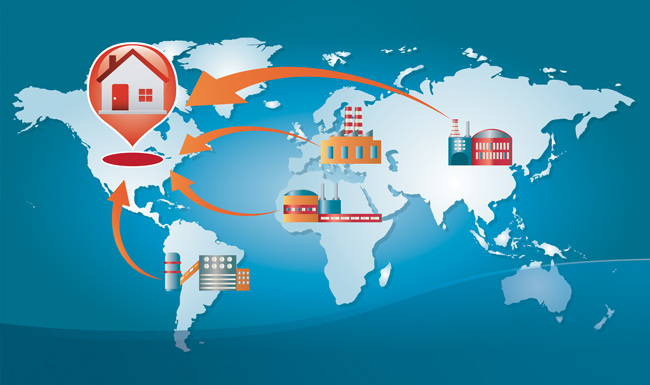
E-Invoicing and Its Geopolitical Stakes
France’s electronic invoicing reform relies on a Y-architecture, where Partner Dematerialization Providers (PDPs) play a central role in issuing and…
Generix Delivers Schematron for Electronic Invoicing to AFNOR to Ensure Interoperability Between PDPs Read the press release

Reshoring and onshoring find companies moving production into their own countries, and nearshoring is the repositioning of those activities to countries that are nearer to the company’s home base. An American firm that relied heavily on Chinese production, for instance, may now be looking to Mexico as a potential nearshoring candidate.
All three strategies are coming up on manufacturers’ radar screens right now. According to a recent Deloitte survey, 83% of companies are diversifying production in order to meet new customer demands (up from 28% prior to the COVID crisis). As part of these efforts, organizations are adapting their operations quickly to respond to the impacts. One such adaptation involves repositioning manufacturing operations closer to home.
“Supply chain resilience strategies that localize critical industries and their component supply chains could not only alleviate the weaknesses uncovered during the COVID-19 pandemic,” Brookings Institute points out, “but also increase employment growth across historically well-paying industries and provide economic development opportunities for U.S. regions with the economic fundamentals conducive to advanced manufacturing.”
Long considered the backbone of the U.S. economy, domestic manufacturing has slowly dwindled as companies offshored production in order to minimize costs and maximize shareholders’ profits. “Since then, wage increases in offshoring countries rose consistently, driving the profits down, making the reason for offshoring less clear,” Gray points out in Reshoring in the COVID-19 Storm.
“Reshoring, bringing manufacturing back to the United States, began to make more sense as companies weighed the Total Cost of Ownership (TCO), which is defined as all the costs of manufacturing a product from beginning to end,” it continues, “especially escalating labor costs, tariffs, quality issues, and unstable supply chains.”
Right now, manufacturers are also coming to terms with numerous other issues that weren’t prevalent during the booming economy of the last 10+ years, including:
Manufacturers have undertaken several initiatives to meet the challenges brought about by COVID-19. They’re developing more responsive plans, for example, and increasing visibility up and down the supply chain to capture the critical hidden links, many of which remain located overseas. They’re also diversifying their supply chains to become nimbler and, as part of this push, reshoring key manufacturing activities. Here are five reasons why:
Reshoring is not as easy as flicking a switch. In the wake of relocation to Asia, for example, many of the domestic manufacturing capabilities up and down the supply chain have atrophied. It’s also important to manage expectations, with “experts [cautioning] that local suppliers do not inherently eliminate risk.” In Supply Chain Dive, PwC’s Mark Hermans points out that “more nearshoring does not necessarily mean that the supply chain is more resilient. It’s still a single point of failure.”
Effectively reshoring production is possible, and it can take one of three forms, with additional levels of complexity and longer timeframes required as you work down this list:
Technology has a role to play in enabling organizations to reshore production. As Supply Chain Management Review reports, “for businesses that decide to migrate their operations, effective inventory management and supply chain tools will be key for success. These include new tracking and authentication advancements, which make visibility across the supply chain more accurate than ever.”
Effective inventory management starts with robust warehouse management systems. Solutions exist today that can ensure any warehouse or distribution center operates at peak efficiency, 24 hours a day, seven days a week. Creating virtual models for facilities and testing them without any impact on ongoing operations is just one example, of how operators can ensure their path to success. From Warehouse Management Systems (WMS) and Transportation Management Systems (TMS) to Manufacturing Execution Systems (MES) and more, software platforms can deliver a wide range of benefits that ultimately flow to the warehouse operator’s bottom line.
Generix Group North America provides a series of solutions within our Supply Chain Hub product suite to create efficiencies across an entire supply chain. Our solutions are in use around the world and our experience is second-to-none. We invite you to reach out to us here to learn more.

France’s electronic invoicing reform relies on a Y-architecture, where Partner Dematerialization Providers (PDPs) play a central role in issuing and…

The B2B mandate in Germany, set to take effect on January 1, 2025, marks a crucial step in the European…

Following the October 15 announcement regarding the abandonment of the PPF development, the DGFIP and its partner AIFE are ramping…

Work with our team to build your ideal supply chain software stack and tailor it to your unique business needs.